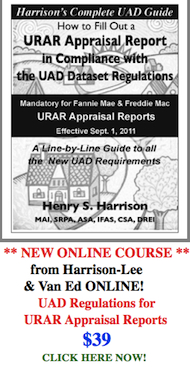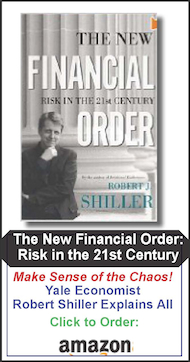Editorial
When Will the Residential Real Estate Recession End?
Soon, later or never? I predict it will last beyond the term of whomever is elected president this fall.
In 2005, my neighbor, the Yale economist Robert Shiller, predicted in “Irrational Exuberance, 2nd Edition” that the Housing Bubble would soon burst. He was called Dr. Doom in the media, and ignored by most people, especially those in government who might have done something to avert the pending crisis.
The bubble did not burst all at once, as in a stock market crash, but rather, values fell more gradually in some markets and much faster in others, proving once again that there is no "national" real estate market in the country, but rather many different markets, each highly dependent upon location (location, location, location).
Now we are coming up to a national election in the fall of 2012 and we keep hearing murmurs that the end is in sight. This may be true in some localities, like the San Francisco Bay area, but I believe it is wishful thinking in most places in the United States. During 2011, over a million houses were actually foreclosed or sold via short sales. Almost double that number entered into the foreclosure process. The current slow down in foreclosures is not due to the improved economy but rather to a slow down caused by the courts, who are now insisting that the foreclosure documents be legally correct. (Revelations of widespread fraud in document preparation has led to what is probably a temporary reprieve for many homeowners who are currently under water.) There are now about 100 million detached single family homes in the United States of which nearly 15 million are underwater. Furthermore millions of them are vacant.
Here is my own experience, which I believe is typical for Florida and many other parts of the country. The house that we purchased three years ago was built in 1995, at a cost including the site of about $225,000. At its peak in 2005, it was worth about $375,000. We bought it for $130,000 and today it would sell for about $110,000. The cost to build it today would be about the same as in 1995, that it, about $225,000. In our solvent 55+ development with nearly 800 units, about 10% of the houses are on the market. This figure has been constant for the past three years, because as fast as houses are being sold, others come on the market. There are practically no new houses being built in our market area. And there is nothing on the horizon that I can see that is going to significantly change this picture in the near future.
I know two families whose homes have been in foreclosure for over a year. Neither of them make any payments on their mortgage, or pay any taxes. If they were served papers today, it would take six months to a year to actually foreclose their homes and get them out. The lender would then have to fix up the houses, which both have deferred maintenance, and will likely take a 25% to 50% loss on both properties. Their neighbors who have been making their payments all along feel like fools whenever they learn that a delinquent homeowner is not only not being foreclosed on, but often having their mortgage renegotiated with more favorable terms. It makes those folks who are "playing by the rules" feel duped by the system.
I don’t see any quick fix to this problem. What will happen if the government forces the banks to "write down" the mortgages for delinquent homeowners — and doesn't do something similar for those people who've been making their payments all along, even though the value of their home has fallen below the unpaid amount of their mortgage?
I know from what I hear first hand and read that these two examples are duplicated in millions of situations throughout the country. When the bubble burst, those of us who predicted it would take at least 10 years for a recovery were accused of being "gloom and doomers." I predict that in 2015, we will be thought of as too optimistic!
1) Keeping interest rates low and making mortgages available to qualified buyers is going to be crucial in speeding a recovery. Real Estate agents report that they have customers who want to buy houses they can afford but are often unable to get financing. Establishing a government program similar to the Resolution Trust Company that was established in the middle 1980s to bail out the Savings and Loan Associations would help. The RTC took over foreclosed houses, fixed them up and resold them. At the time, this program was predicted to cost the government about $500 billion dollars. When it was all over, however, the cost was less than $50 billion.
2) Let corporations bring back the billions of dollars they currently hold in their overseas accounts at a reasonable tax rate. Force them to plow that money back into the economy and not hoard it, as they did the last time this was tried.
3) Encourage employees to buy homes in the areas near their work place. In New Haven where we live, Yale University has a very successful program whereby they subsidize their employees who buy homes near the campus by giving them $2,500 per year for 10 years towards their mortgage payments. This encourages revitalized neighborhoods and strong economic growth in their vicinity. In fact, these neighborhoods adjacent to Yale were the least affected by the economic downturn in the entire nation!
4) Fix our broken immigration policy. There are over 25 million legal immigrants and about 12 million illegal immigrants in the USA. No matter how you feel about this situation, the reality is that most of them will remain in the United States, and many of our farming areas are completely dependent on them for their labor force. Now, these immigrants are afraid to buy a house even though many can afford to do so. It's not a question of them becoming citizens that stops them from buying houses; the problem is that they do not have permanent status and are afraid they may be deported, even though almost all of them will end up permanently in the US. By accelerating their change of status from temporary residents to permanent residents (at very little cost) it would create millions of potential new homeowners -- and taxpayers.
5) Conventional wisdom is that to be healthy, the housing industry needs to build and sell about 1.5 million housing units a year. The good news is that the population of the United States increases at a rate of over 2.5 million people each year, combining birthrates and immigration. This translates into at least one million additional families per year needing housing. So without doing anything, sooner or later the excess inventory of houses will vanish, and the housing shortage will be solved. Still, it's hard for me to see any possibility that the over-supply of housing, which continues to depresses the need for new houses and all the "stuff" that goes into them, is going to be resolved in the next couple years. My guess is it that the housing situation will still be a campaign issue in the presidential election of 2016.
One final ironic note: we complain that we outsource — to China and other countries — the manufacture of almost everything sold in a Walmart. And yet, the one thing that can’t be outsourced is housing construction. A robust housing market is the greatest primer for the American economy. Let's hope it comes back sooner than I've predicted.





















